PASSING THE BALL:
Wounded Witnesses, Wounded Storytellers shedding light on the systemic and traumatic effects that relatives have to face after someone in their family has been incarcerated in the U.S.
WITH THE TALKING BALL v1-v3
Between October through December 2009
During the first semester at MIT, I developed a pilot project titled Passing the Ball: Wounded Witnesses Wounded Storytellers. The purpose of the project started by asking myself how could I learn to express my heartbreaking stories and of those near my life in a safe, playful, and inquisitive way in order to overcome “la llorona effect”[1] inside my body and be a better advocate in public life. As a result, I made an audio interactive device the Talking Ball to accompany a multimedia live action, public intervention, and participatory installation.
For the 1st version, I did a multimedia live action. For the 2nd version, I organized a public intervention outside the Mission High School, San Francisco – CA. For the 3rd version, I made a participatory/performative installation for finals at the MIT Program in Art, Culture, and Technology. For the last event, the project included the stories of three women in my life whom I interviewed and I asked: How have the incarceration of their relatives affected their life?
OCTOBER 09.2009
In October 2009, Version 1 was presented for the Interrogative Design class led by professor krzysztof wodiczko.
For this first experiment, I recorded my voice and only my eyes while I was doing a live psychoanalysis session about how it didn’t help to separate my friend’s daughter and my relative from our families because this made the situation worse for everyone. With this material, I had a black ball, and I simulated the effect where as long as the ball was rolling we can all hear the voice and video behind me. The moment the ball stopped moving, everything stops. I also blinded folded my eyes and left everything to chance. As the audience noticed the ball rolling and their participation for the performance to work, I was also eliciting to replay the story, and by replaying the story I was also passing on the story to others even if was not very legible. I named this presentation, “Passing the Ball: Unlocking Stigmas of Violence and Trauma”.
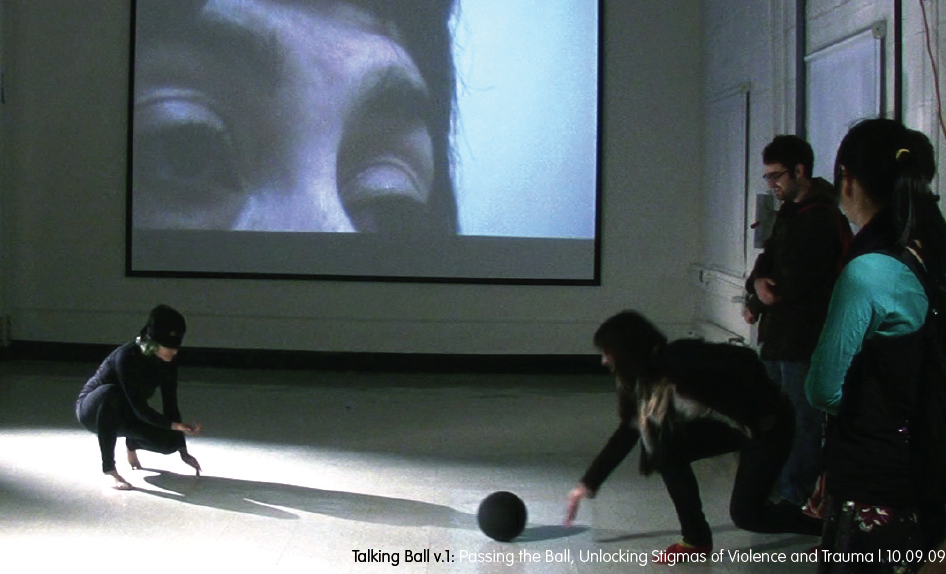
NOVEMBER 29.2009
Version 2, presented in San Francisco, CA.
I did a performance in public space at the location from where one of the stories originated (at Mission high school, San Francisco – CA). This one I did with Flora and among friends. The ball this time was larger and unique. This object was a self-contained transitional object audio piece, which my friend Flora named the “Talking Ball”. The Talking Ball became the transitional object, which psychoanalyst and theorist D. W. Winnicott identifies as a special object a youngster unconsciously creates as companions but helps them transition into awareness about themselves and their environment. In my case, the Talking Ball has served as a playful device where I was able to connect, learn and decode intimate memories, which were too close and inside of me while I was also opening up the possibility for others to learn upwardly a little bit of this experience. Unfortunately, the sound quality of the talking ball was imperfect and my voice was also obscured by my accent and cry, which added to the paradox of the wounded witness.
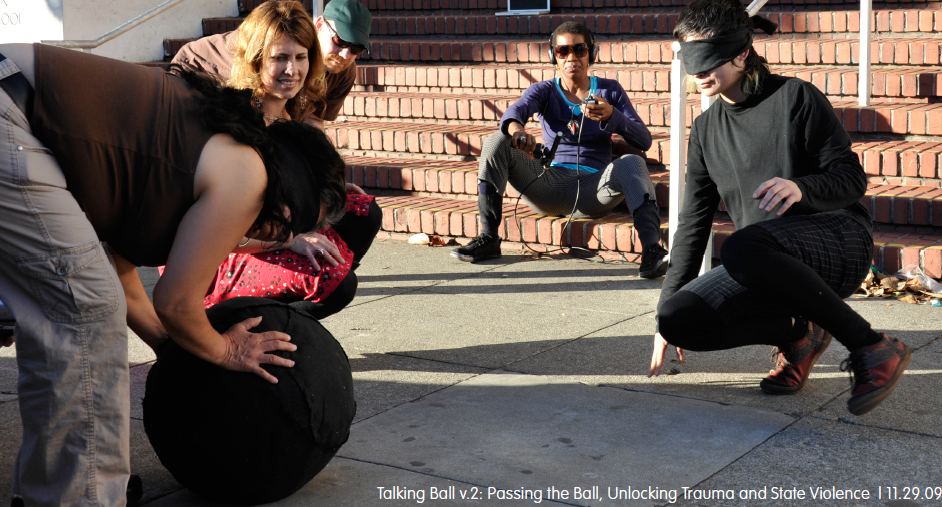
DECEMBER .2009
Wounded Witness, Wounded Storyteller — [Manifesto]
In trying to answer questions raised in the midterm, I understood that it was not a task I can do alone. Drawing on my experience of years of activism, I recognize that in order to envision ways to transform the State Apparatuses that control our lives, we (families, ex-prisoners, activists…etc) need to unite to form a political body. However, just like myself who is affected by the traumatic effects of having to live with the removal of my brother from society and witness his unbearable conditions, it is an extremely difficult task to even speak about.
As an artist, educator, and agent for social change, I have come to the conclusion that formulating abstract voyeuristic interventions or creating socially engaged work locally without a connection to a community is not adequate. On one hand, I will be positioning myself, as the “rebel artist”.On the other, I will be crossing ethical lines – the artist as the “Social Worker” or “Ethnographer” (G. Kester). Instead, I am taking a radical position – I will be working as the wounded witness, wounded storyteller.
The wounded witness, the wounded storyteller is a social agent who can be described in four ways.
• One, she is a witness by chance. In general, the witness by chance accidentally observes people who are susceptible to state abuse, torture, mistreatment, incarceration, negligence, marginalization, and so forth. (Ex: prisoners, children, elders, disable, immigrants, refugees, historically oppressed citizens, etc.) Often these are close relatives, friends, and even neighbors who are vulnerable to losing their civil liberties and human rights or being taken away by the State.
• Two, she is a wounded storyteller; is “a person who has or has had a disease” and “talks about the sick body” (A. W. Frank) that lives beneath the normal façade of her physical structure. She has been living in an ill state because she suffers from an invisible illness, but in this postmodern era, she can claim her wounded body and share her story.
• Three, she works with a community that shares similar issues with the artist.
• Four, she is not immune to State and Institutional violence because she can be a target as well. However, she cannot afford to succumb to physical restraint, lose the ability to speak out, and to be arrested. Therefore, she stays in the margins, between the privileged and the dispossessed of society. This situation allows her to voice her convictions along the spectrum of both groups.
After years of trying to work around the pain inflicted in me by my brother’s situation, I recognize that I need to examine it, study it and find ways to speak out. It is not a task that can be done alone. But working in the company of others will assist me to overcome my fears, abolish my sense of shame and confront my own misconceptions; enabling me to help others too.
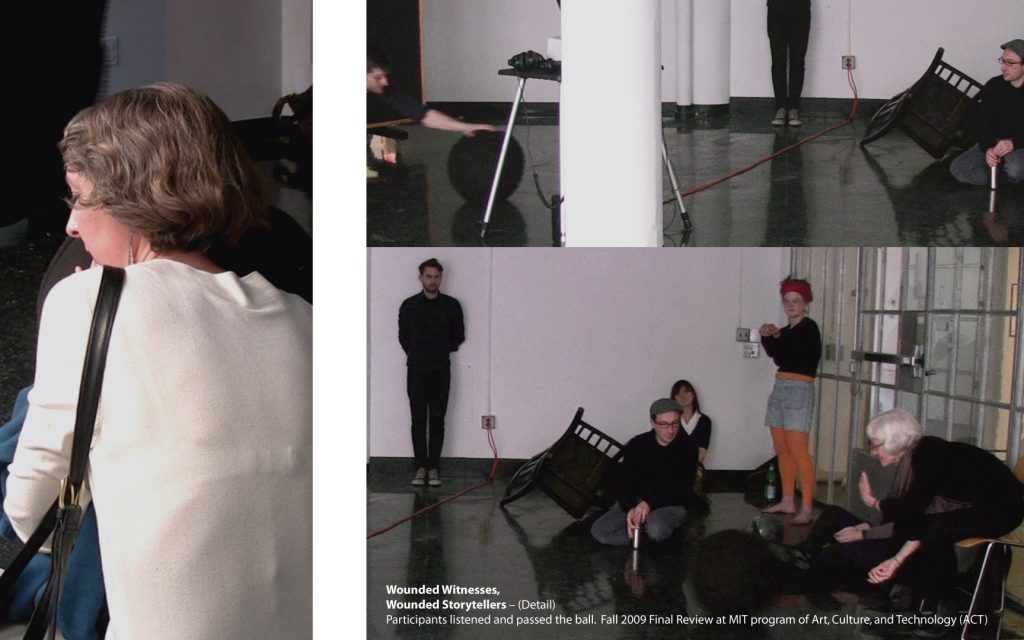
DECEMBER 16.2009
Version 3 was presented during finals at ACT-MIT.
Mediums: Installation, 3 audio tracks of three women, 3 mp3 players, a talking ball version 3 a home made single channel speaker, house paint, ink and public participation.
This version of the project consists of an installation, relational/transitional object, audio documentary and public participation that minimally embodies and sheds light on the systemic and traumatic effects that relatives have to face after someone in their family has been incarcerated in the U.S.
For the project, I interviewed 3 women who had been long-time collaborators from San Francisco, CA, and asked them, How have the incarceration of their relatives affected their life? Each of the interviewees’ stories was sampled and recorded in three single-channel mp3 players for the installation and as part of the event composition.
The work was presented for final review at the program of Art, Culture, and Technology – MIT, fall 2009. The event and installation involved a talking ball with an audio speaker that was passed around in various random manners, eliciting the audience to listen carefully, refuse, and even play with the intimate audio testimonies. In its completed form, the project indirectly provoked the audience to feel from indifference, resilience, frustration, sorrow, and grief to a deep sense of injustice. It is an array of experiences that are commonly unknown but commonly lived by the Wounded Witnesses, Wounded Storytellers of this project.

[1] 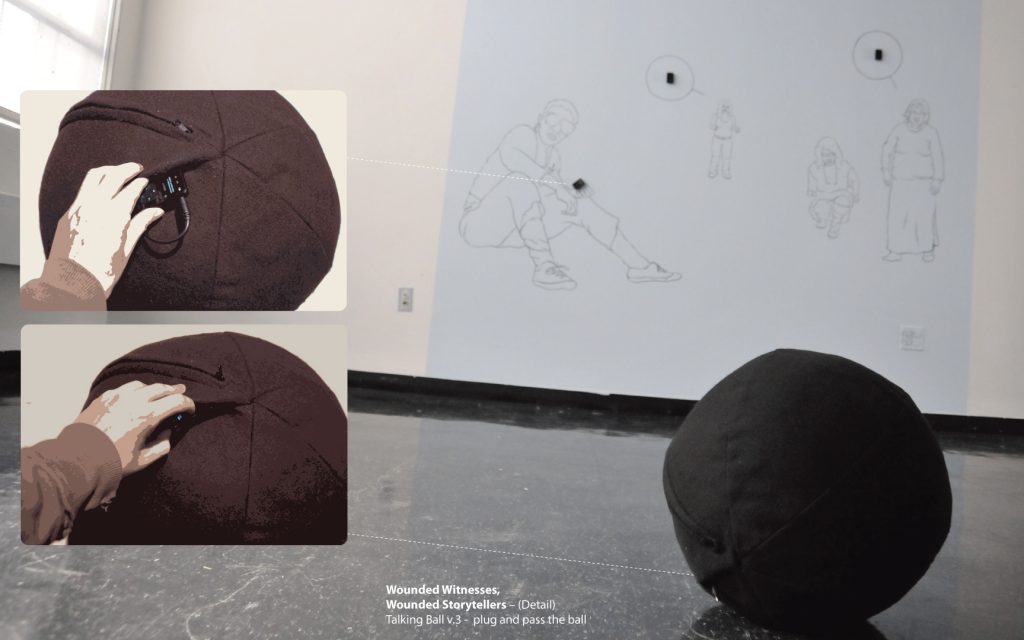
[2] 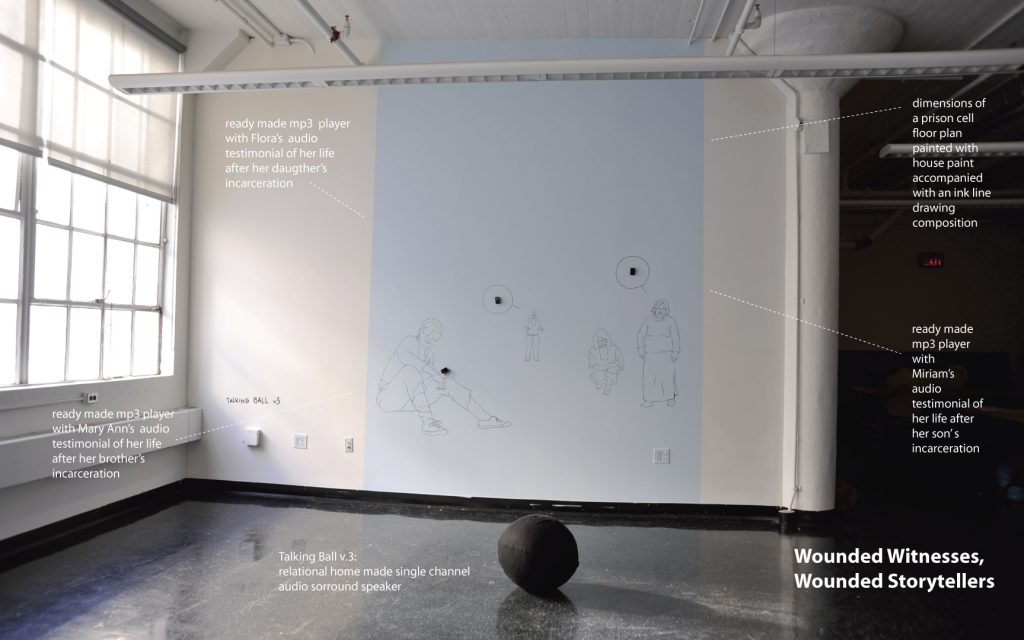
[3]
Image_01 – Detail: ink line drawings of collaborators names
Image_02 – Detail: talking ball v.3 – homemade speaker as a transitional object
Image_03 – Overview: project installation w/descriptions at MIT building N52 – Fall 2009
[1] (a) Serrano, Stephanie. 2009. No more tears: La Llorona at the crossroads of feminism, postmodernism, and futurity in Chicana theory and criticism. Arizona State University. (b) La Llorona is a Spanish word, which means ‘the crying woman’. It is a very popular legend in the world of the Spanish and in cultures in South America, and even America. There are many versions of this story that are told from person to person.
